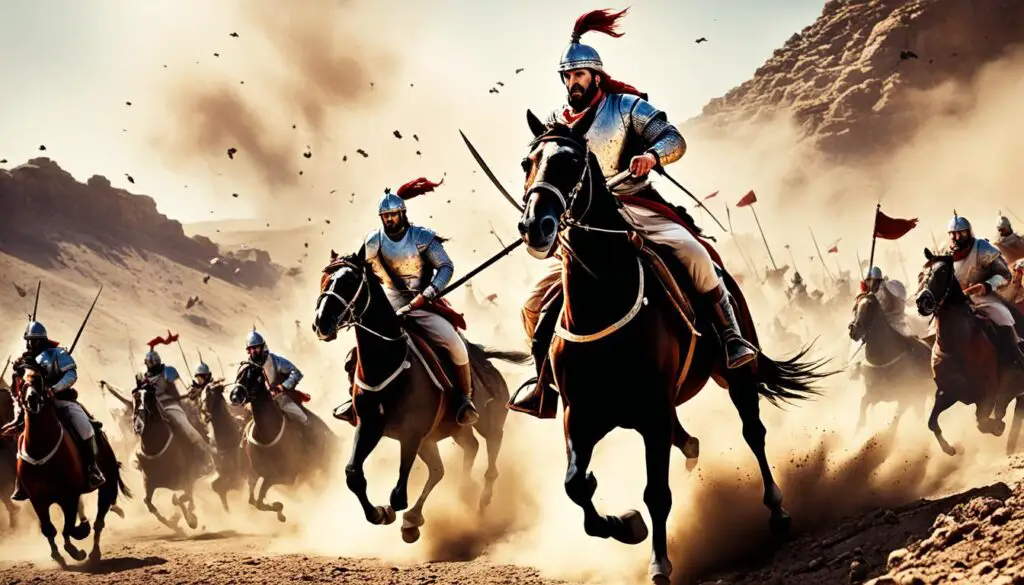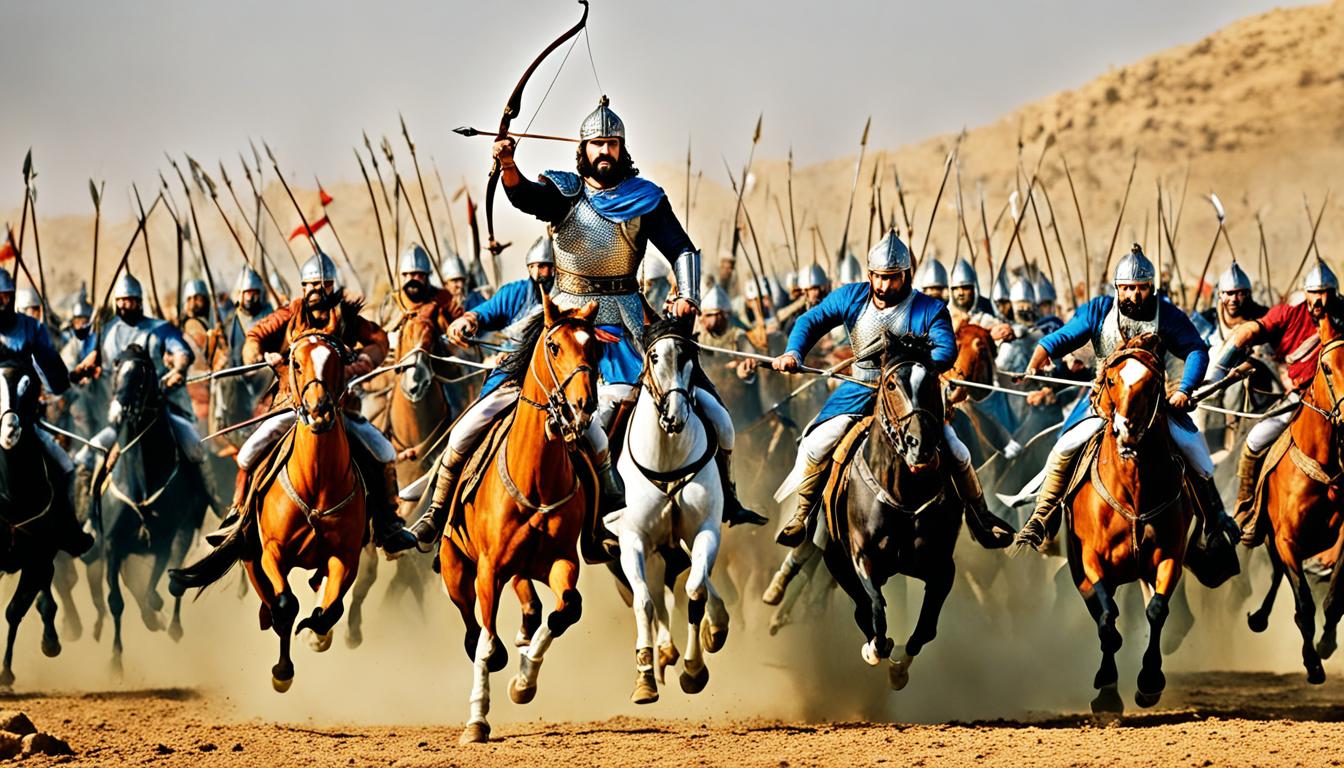Have you ever wondered how a single battle could shape the course of Indian history?
The Battle of Tarain, fought between the Ghurid empire and the Chauhan dynasty, was not just a clash of armies, but a turning point in the struggle for power in medieval India. Led by the ambitious Muhammad Ghori, the Ghurids sought to expand their empire into the Indian subcontinent, while Prithviraj Chauhan and his Rajput allies fought to defend their land and independence.
In this article, we will explore the key historical facts and lasting impact of the Battle of Tarain, including the strategies employed by both sides, the events during the battle, and the aftermath that ultimately led to the establishment of Islamic dynasties in India.
Prepare to dive into a riveting tale of conquest, valor, and the ripples of a single battle that shaped the destiny of a nation.
Key Takeaways:
- The Battle of Tarain was a series of conflicts fought between the Ghurid empire and the Chauhan dynasty in medieval India
- Led by Muhammad Ghori, the Ghurids aimed to expand their empire into the Indian subcontinent
- The battle marked a turning point in Indian history and set the stage for future conflicts
- The Ghurids emerged victorious, leading to the establishment of Islamic dynasties in India
- The Battle of Tarain had a profound impact on the political landscape of medieval India
Events during the First Battle of Tarain
The first battle of Tarain, fought in 1191, was a significant clash between the Ghurids, led by Muhammad Ghori, and the Rajputs, commanded by Prithviraj Chauhan. This battle played a crucial role during the Arab and Turkish invasions of India and took place on the fields of Tarain, located 150 kilometers north of Delhi.
Though contemporary sources estimated the Rajput forces to number around 200,000 and the Ghurid forces around 100,000, modern historians suggest that the actual numbers were smaller. Despite this, the battle showcased the Ghurids’ superior cavalry archers and the Rajputs’ strength in numbers and the use of elephants in combat.
The battle commenced with a probing attack by the Ghurid archers, testing the Rajput formation. Then, the Rajputs launched an all-out assault, sweeping across the battlefield. As the Ghurid horse archers began to retreat, the Rajputs pursued them relentlessly, initiating a fierce pursuit.
In the ensuing chaos, the Rajput cavalry overwhelmed the Ghurid flank, while the Rajput elephants applied immense pressure to the remaining Ghurid troops in the center. Muhammad Ghori attempted to rally his troops, but during this crucial moment, Govind Rai, the commander of the Rajput forces, threw a spear that knocked him almost unconscious.
Witnessing their leader incapacitated, the Ghurid troops’ morale plummeted, and they fled the battlefield in disarray. The Rajput forces pursued the retreating Ghurids for nearly 40 kilometers before diverting their attention to the fort at Bathinda, which eventually fell a year later in 1192.

The events during the first Battle of Tarain demonstrate the dynamics of warfare between the Ghurids and the Rajputs. The battle’s outcome signaled a significant turning point in Indian history and set the stage for future conflicts between these powerful factions.
Aftermath of the Battle of Tarain
The Battle of Tarain had profound consequences that shaped the course of Indian history. It marked the beginning of the Ghurid incursions into India and the eventual establishment of the Delhi sultanate, a powerful Islamic dynasty that ruled northern India for over three centuries.
Following their victory at Tarain, the Ghurids swiftly seized control of several forts, including Hansi, Saraswati, and Samana. They then turned their attention to Ajmer, capturing the city after a fierce battle. Prithviraj Chauhan, the leader of the Chauhan dynasty, may have initially been allowed to rule Ajmer as a Ghurid vassal, but he was eventually executed for alleged conspiracy.
Undeterred by their initial setback, the Ghurids continued their incursions into India. In 1194, Muhammad Ghori, the Ghurid leader, returned with a renewed force, capturing the strategic forts of Bayana and Gwalior to secure the southern flank of Delhi. Ghurid generals, such as Qutbuddin Aibak and Bakhtiyar Khalji, founded their own dynasties and expanded their territories in India, further consolidating Ghurid rule.
The power vacuum created by the decline of the Ghaznavid empire and the Ghurid conquests paved the way for the emergence of the Delhi sultanate. This centralized Islamic state would go on to play a significant role in shaping the political and cultural landscape of northern India. While the Chauhan dynasty was displaced from Delhi, Prithviraj Chauhan’s son established a new Chauhan dynasty in Ranthambore, carrying on the legacy of resistance against Ghurid rule.
FAQ
What is the Battle of Tarain?
The Battle of Tarain refers to a series of significant conflicts fought between the Ghurids and the Rajputs in the 12th century.
Who were the key leaders in the Battle of Tarain?
The battle was led by Muhammad Ghori, the Ghurid ruler, and Prithviraj Chauhan, the Rajput warrior.
When did the first Battle of Tarain take place?
The first Battle of Tarain occurred in 1191.
What were the outcomes of the first Battle of Tarain?
The Rajput forces emerged victorious, marking a turning point in Indian history and setting the stage for future conflicts.
What were the key strategies employed in the first Battle of Tarain?
The Ghurids relied on superior cavalry archers, while the Rajputs used elephants and outnumbered their opponents.
How did the aftermath of the Battle of Tarain impact India?
The Ghurids captured several forts and established their rule, which eventually led to the establishment of the Delhi sultanate.
Source Links
- https://en.wikipedia.org/wiki/First_Battle_of_Tarain
- https://www.clearias.com/battles-of-tarain/
- https://byjus.com/free-ias-prep/first-battle-of-tarain-1191/

